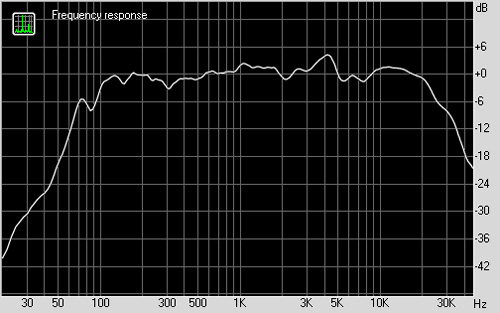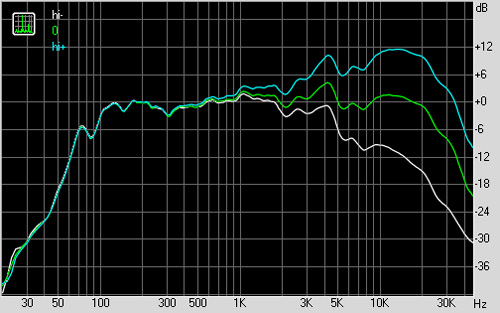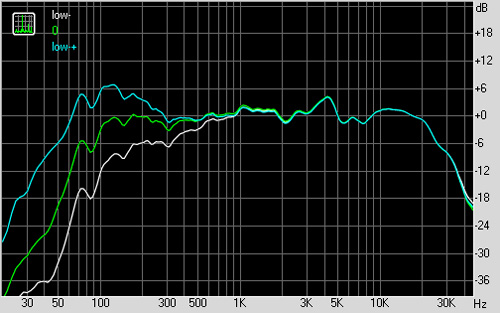SVEN STREAM Light
Functionality
Speaker cases have graining sides, at that judging by the information on the box a customer may choose out of four color versions: walnut, cherry and dark oak. Side panels are not flat, but a little bit chamfered to edges and that adds some elegance to speakers. Other planes are covered with black laminated board with light impression, and the glossy plastic control panel is located in the front panel lower part of the active speaker, where the volume control and LF/HF timbre control are placed. They have stop blocks in extreme positions, but timbre controls are without center position fixation. There is also green LED power on indicator and the headphones jack there.
There is soft fabric removable grill on the MDF framework, where round openings are available in front of loudspeakers. The grill fastening is the most ordinary for inexpensive speakers – thin plastic pins with balls at the end.
Acoustic appearance is a phase inverter; the port output is on the rear side. MDF thickness of the case is equal to 9 mm; there is a piece of padding polyester inside, which covers completely one sidewall and practically the whole top wall.
There is only one 2×RCA input, jack to connect the passive speaker, mechanical power switch and fuse, as well as a radiator of the power amplifier on a metal plate, which closes a cut in the active speaker rear wall through the gasket. The opening, where the power cable goes through, is at the very bottom.
The LF/MF loudspeaker 9 cm in diameter (4 Ом, 30 W) has a paper cone on rubber suspension, but the tweeter (6 Ом, 24 W) has the fabric dome one inch in diameter. Joints of loudspeakers with the front panel have gaskets.
The power supply is provided based on the low-frequency transformer with 2×15 V and 2 A current; there are 4700 mF condensers after the amplifier. Well-known TDA2050 analog microcircuits are used as power amplifiers, at that loads are connected to them according to the bi-amping diagram, i.e. every loudspeaker of both speakers is connected to its own amplifier. All four TDA2050 are placed on one board, which is fixed from the inside on a removable metal plate, and there is a ribbed radiator on its outside, where microcircuits are located. Standing current of the low-frequency amplifier microcircuits is quite high, and what is more there are four microcircuits there and the radiator is heated up to 20-21°C in the absence of a signal, at that the whole back metal plate becomes perceptibly warm.
Low-current circuits, such as preamplifiers, amplifiers for headphones, active filters of 4-th order for frequency demultiplexing of channels and volume and timbre control circuits are located on the second board located inside the speaker and fixed on the control panel. They are based on two doubled NE5532 operating amplifiers and two quadruple TL084 amplifiers.
Speakers are connected with the help of a cable 2.5 m long, both ends of which have 4-pin XLR connectors fixed with captive nuts.
Besides this cable, there is the User's Manual and 2×RCA–mini-jack cable for connection to a signal source in the package content, as well as a connector, which makes it possible to transfer this cable into 2×RCA–2×RCA cable. Well, this solution even if economical, but it is quite universal, especially for the only 2×RCA input.
Advantages:
Disadvantages:
Doubtful solutions:
Measurements in RMAA
As judged from our measurements, when the unevenness is equal to ±6 dB, the operation range of Sven Stream Light makes 70 Hz–30 kHz. The amplitude-frequency characteristic diagram is quite smooth on the whole, and the available irregularity is typical for such class speakers, therefore such results are to be considered quite good.
High frequencies are controls within the range of ±24 dB, low frequencies ±18 dB.
Sounding
Sounding of SVEN STREAM Light speakers should be characterized as good. The main advantage of speakers is their quite good sounding at middle frequencies and good reserve in control of LF range. Of available shortcomings, it is necessary to highlight great number of distortions in the high-frequency area and audible resonance in the transition zone.







